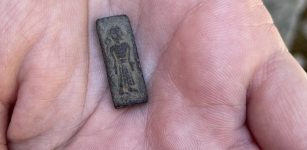Buhl Woman Of Idaho: One Of The Oldest Skeletons In North America
Ellen Lloyd - AncientPages.com - In January 1989, a worker discovered the remains of an ancient skeleton in a quarry near Buhl, Idaho, United States.
The skeleton was named the Buhl Woman, sometimes referred to as “Buhla, and it's truly unique. The 11,000-year-old skeleton is one of the oldest skeletons ever discovered in North America.
Left: Skull of Buhl Woman Right: Burial where the Buhl Woman was discovered. - source
Only a handful of skeletons of this age had previously been unearthed in North America.
Before the Buhl Woman was reburied in 1991, scientists from the Arkansas Archeological Survey examined the body. The Buhl Woman died young, when she was only between 17 and 21 years old.
Radiocarbon dating of the bones revealed she died at 10,675 ± 95 B.P. (before the present).
Analysis of different carbon and nitrogen isotope ratios in Buhl Woman's bone collagen suggests that she mainly ate meat and some fish. At the same time, wear patterns on her teeth indicate that the food was cooked before being eaten.
Artifact discovered in the Buhl Woman burial. Image credit: Peter A. Bostrom - source
This finding meshes with recent discoveries in Peru, suggesting that the Paleoindian diet was much more complex and varied than the longstanding "big game hunter" hypothesis would allow. At two 11,000-year-old sites, archaeologists have found evidence of the butchering, cooking, and eating of birds, fish, and shellfish.
Further examinations showed her skull was similar to American Indian and East Asian populations. It contrasts with the morphology of several other early skulls, including Kennewick Man, described as Caucasoid.
According to anthropologist Richard Jantz of the University of Tennessee, the Buhl Woman did not fit into any modern group but was most similar to today's Polynesians. Twenty-five teeth were recovered from the Buhl burial.
Artifacts discovered in the Buhl burial appear to be offerings. Image credit: Peter A. Bostrom - Pete Bostrom, Lithic - source
What caused her death remains unknown, but she appeared generally healthy then. However, her tooth enamel and bone development indicated periodic malnutrition and stress. It is possible the nutritional stress was due to seasonal and/or the result of childhood diseases.
Four artifacts and one unidentified incised badger were found with the Buhl skeleton.
The badger bone was most likely a grave offering because no other bones were found at the site. The other artifacts included one pressure-flaked stemmed biface, a portion of a bone needle, and two fragments of an incised bone awl or pin. Scientists suspect the artifacts were burial offerings.
Sketons Older Than The Buhl Woman Have Been Found In America
The Buhl Woman is one of the oldest unearthed skeletons in North America, but archaeologists have also found even older human bones. As previously discussed on Ancient Pages, "an 11,500-year-old skeleton discovered in Alaska raises new questions about who inhabited North America in the distant past.
Examination of the skeleton shows North America was settled by previously unknown people who lived there, creating several settlements and later mysteriously vanishing.
The 12,700-year-old Anzick Child is the oldest genome ever found in the Americas. This is the second-oldest human genome ever found on the continent, and it belongs to a young child, a girl who was just six weeks old when she died.
Scientists say there has never been any ancient Native American DNA like it before and hailed the genetic evidence as a milestone."
New archaeological discoveries will, without doubt, shed more light on the first inhabitants of North America, but the Buhl Woman is and will long remain a fascinating find.
Written by - Ellen Lloyd – AncientPages.com
Updated on November 30, 2023
Copyright © AncientPages.com All rights reserved. This material may not be published, broadcast, rewritten or redistributed in whole or part without the express written permission of AncientPages.com
More From Ancient Pages
-
 DNA Sheds New Light On The Mysterious Dead Sea Scrolls
Archaeology | Jun 2, 2020
DNA Sheds New Light On The Mysterious Dead Sea Scrolls
Archaeology | Jun 2, 2020 -
 Satellite Images Reveal Ancient Mesopotamian City Pre-Dating The Egyptian Pyramids
Archaeology | Mar 10, 2022
Satellite Images Reveal Ancient Mesopotamian City Pre-Dating The Egyptian Pyramids
Archaeology | Mar 10, 2022 -
 Bulla Felix: Legendary Italian Leader Of Outlaws Who Robbed The Rich And Gave To The Poor
Featured Stories | Mar 23, 2023
Bulla Felix: Legendary Italian Leader Of Outlaws Who Robbed The Rich And Gave To The Poor
Featured Stories | Mar 23, 2023 -
 Ancient DNA Reveals “Completely Unexpected” Marriage Rules In Minoan Crete
Archaeology | Jan 16, 2023
Ancient DNA Reveals “Completely Unexpected” Marriage Rules In Minoan Crete
Archaeology | Jan 16, 2023 -
 Kava – Astonishing Ancient Plant That Improves Emotional Intelligence Is Gaining Popularity In The Western World
Featured Stories | Mar 31, 2018
Kava – Astonishing Ancient Plant That Improves Emotional Intelligence Is Gaining Popularity In The Western World
Featured Stories | Mar 31, 2018 -
 Hundreds of Monumental ‘Kites’ Spotted in Arabian Desert
Archaeology | Sep 12, 2022
Hundreds of Monumental ‘Kites’ Spotted in Arabian Desert
Archaeology | Sep 12, 2022 -
 Rare Hidden Copy Of Shakespeare Sonnet 116 Discovered In A 17th-Century Poetry Collection
Linguistic Discoveries | Mar 24, 2025
Rare Hidden Copy Of Shakespeare Sonnet 116 Discovered In A 17th-Century Poetry Collection
Linguistic Discoveries | Mar 24, 2025 -
 Did Neanderthals And Modern Humans Meet In The Czech Republic 50,000 Years Ago?
Archaeology | Jun 17, 2017
Did Neanderthals And Modern Humans Meet In The Czech Republic 50,000 Years Ago?
Archaeology | Jun 17, 2017 -
 Secret Underground Chambers Of Caynton Caves And The Knights Templar Connection
Featured Stories | Aug 13, 2019
Secret Underground Chambers Of Caynton Caves And The Knights Templar Connection
Featured Stories | Aug 13, 2019 -
 Stunning Underwater Photos Reveal Secrets Of Legendary Lost City Of Heracleion
Featured Stories | May 4, 2013
Stunning Underwater Photos Reveal Secrets Of Legendary Lost City Of Heracleion
Featured Stories | May 4, 2013 -
 Rare Kakatiya Dynasty Sculptures Discovered Near A Temple In Telangana, India
Archaeology | Jul 24, 2021
Rare Kakatiya Dynasty Sculptures Discovered Near A Temple In Telangana, India
Archaeology | Jul 24, 2021 -
 Suprising Discovery Of A Well-Preserved Ancient Roman Road In London, UK
Archaeology | Nov 19, 2024
Suprising Discovery Of A Well-Preserved Ancient Roman Road In London, UK
Archaeology | Nov 19, 2024 -
 Rare And Tiny Ancient Stamps Found In Falster May Show The Way To An Unknown King’s Home
Archaeology | Jul 26, 2023
Rare And Tiny Ancient Stamps Found In Falster May Show The Way To An Unknown King’s Home
Archaeology | Jul 26, 2023 -
 Unusual Double Temple Of Kom Ombo Dedicated To Crocodile God Sobek And Falcon-Headed God Horus
Featured Stories | Mar 14, 2016
Unusual Double Temple Of Kom Ombo Dedicated To Crocodile God Sobek And Falcon-Headed God Horus
Featured Stories | Mar 14, 2016 -
 Silver Coins Hidden In Chess Figure Date Back To Ivan The Terrible’s Days – Discovery In Moscow
Archaeology | May 13, 2017
Silver Coins Hidden In Chess Figure Date Back To Ivan The Terrible’s Days – Discovery In Moscow
Archaeology | May 13, 2017 -
 Face Of Queen Lady Cao Reconstructed – Unique Look At The First Known Female Ruler In Peru
Archaeology | Jul 10, 2017
Face Of Queen Lady Cao Reconstructed – Unique Look At The First Known Female Ruler In Peru
Archaeology | Jul 10, 2017 -
 Ancient Trans-Atlantic Emigration Theory – Not Supported By Genetic Data, Researcher Says
Archaeology | Jan 18, 2016
Ancient Trans-Atlantic Emigration Theory – Not Supported By Genetic Data, Researcher Says
Archaeology | Jan 18, 2016 -
 Weird Archaeological Discovery In Ancient Scottish Cave – A Neolithic And Celtic Mystery
Featured Stories | May 30, 2024
Weird Archaeological Discovery In Ancient Scottish Cave – A Neolithic And Celtic Mystery
Featured Stories | May 30, 2024 -
 Amazing Restoration Of Ancient Roman Vineyard Buried Underneath The Ash Of Mount Vesuvius For 2,000 Years
Archaeology | Nov 27, 2020
Amazing Restoration Of Ancient Roman Vineyard Buried Underneath The Ash Of Mount Vesuvius For 2,000 Years
Archaeology | Nov 27, 2020 -
 On This Day In History: Dante Alighieri Famous For His ‘Divine Comedy’ Born – On May 9, 1265
News | May 9, 2016
On This Day In History: Dante Alighieri Famous For His ‘Divine Comedy’ Born – On May 9, 1265
News | May 9, 2016



